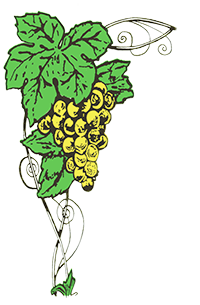CHARDONNAY Grape Variety
Our Chablis wines are made from the noble CHARDONNAY variety of grape. Grafted in the nursery on to rootstock that is resistant to phylloxera and suited to the soil composition, the vines are planted out at a density of 5,800 plants to the hectare. After 3 years, the vine becomes fruit-bearing and can claim its specific denomination, except the Grand Crus, which must be grown for four years.
The growth cycle is roughly the same year by year:
From December to March:
When the last leaves have fallen it is time to begin pruning the vines. This consists of removing all but three branches in order to train new shoots and promote regular growth to improve the future production of fruit. It is a meticulous job which requires a great deal of experience and good judgement on the part of the grower. Poor pruning means that canes grow unchecked, which would weaken the plant and prevent it from fruiting normally.
In April:
Trellising: This consists of training the remaining canes along the lower trellis wire. This slows the flow of sap which in turn restricts over-vigorous growth while encouraging fruiting.
Planting: new stock is planted at this time of year. The year-old grafts are lifted in the nursery and these young plants can now be planted out in suitably prepared earth. The denomination of Appellation d’Origine Contrôlée can only be attributed to the plant after three years.
From April to May:
Frost protection: the vines have begun to break bud by this time, which means that the buds have started to open to show the cluster from which young leaves will appear. Wine growers are very wary of this time of the year, as spring frosts are still possible and can destroy the entire harvest. Different ways of dealing with this problem are employed, including spraying with water and oil heating systems.
Protective measures: phytosanitary treatments against diseases such as downy or powdery mildew and against parasites such as vine moth and spiders are applied at this period of the year.
In June and In July:
Trellis work: the canes now have to be raised and trained between the trellis wires to avoid unruly growth and drooping. The trellis wires are then tightened with special staples.
Summer pruning: this consists of trimming the tips of vine shoots which grow vigorously and divert nutrients away from grape growth. It is carried out with the help of tractor-mounted pruning equipment.
In September:
Leaf thinning: removing leaves growing near or over the grape clusters allows a greater level of sunlight to reach the fruit and prevents the grey mould caused by the botrytis fungus.
The grape harvest is the result of a year’s growth and many months of hard work, and can start 100 days after the vine has flowered. A mustimetre or saccharimeter is used to measure the sugar level of the must (juice) over several days. The vintage (grape harvesting) can take place when the sugar level has stabilised. The grapes are picked by hand or by machine.
